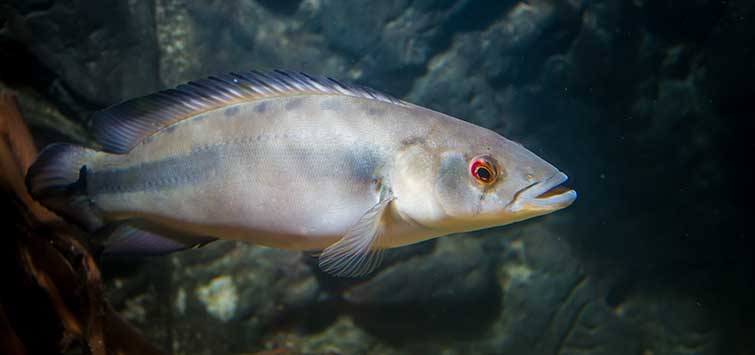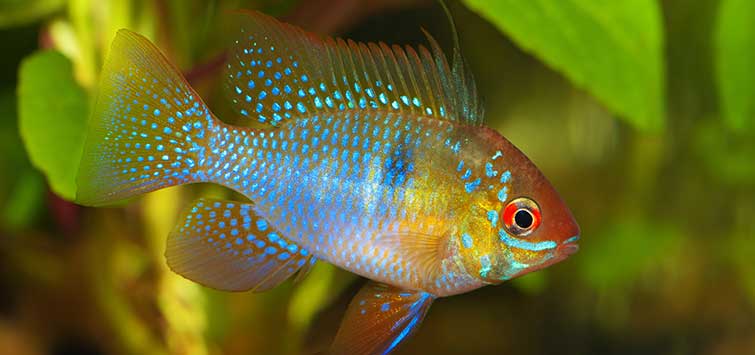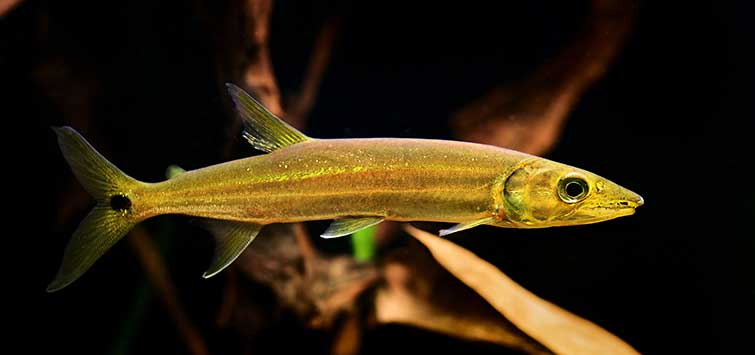Pike Fever
Author: Hudson Ensz
Residing in a location brimming with exotic species, our young author becomes captivated by an intelligent and agile pike. Read about its habitat and why its reputation for extreme aggression may be unjustified.
Our Search for Tropical Fish
The cars zip past us as we stand in front of a very busy road in Manaus, Brazil. We cross the street and after three minutes we arrive at a local fish store, where beautiful Jack Dempseys swim to and fro in one of the show tanks and tiny baby angelfish dart hither and thither. But these were not what I wanted—I eventually spotted one of the fish I was looking for, a red-tailed black shark Epalzeorhynchos bicolor, for an appealingly good price. But there was one more pet shop I had wanted to try out. We walked another five minutes to the other fish store, and I looked around for a bit, but didn’t find too much.
The Catch
As I was leaving, out of the corner of my eye I saw a 3-inch fish with a black horizontal band from its mouth to the beginning of its black-spotted tail. The area below the band was pearly white, and above the band was a mossy green. The dorsal fin was long, and edged in a slight red. I asked for the name of the fish. “JacundÁ,” the shop owner said. The Portuguese name didn’t mean anything to me at the time, but I knew I had heard of it before, and I had also seen that fish somewhere in a book.
Expecting the price to be outrageously high, I was pleasantly surprised when the clerk said “5 reais” (about US$3). After thinking it over a great deal, I decided to buy it, even though the clerk warned me about its aggressiveness.
Once home, I immediately fell upon my books, and the beautiful world of cichlids opened before me in a whole new way. I had my very own pike cichlid! I was smitten. With my pike cichlid in its new home, I needed to identify it. First I thought it was a Crenicichla proteus, but a couple of hobbyists suggested that it was a C. lucius or C. regani. After further research, I determined that it was C. regani, the dwarf pike. I was very relieved that I wouldn’t have an 8-inch fish to deal with!
Equipment and Fishkeeping History
My pike’s new home was a custom-made, 70-cm (27-inch) tank. Its other tankmates were a young Aequidens diadema, an unidentified 4-inch catfish, not to mention some otos Otocinclus macrospilus, barbs Puntius arulius, and cories Corydoras schwartzi. I also had a 3-gallon tank, and a little later I got a 10-gallon tank. Now I have six tanks, mostly small ones.
The pike was not quite the first cichlid I have had. I used to have some Dicrossus filamentosus, a species that is rarely the first cichlid a newbie comes across (but they are fairly easy to come by in the Amazon). Because of my growing fascination with cichlids, I began to look for more information on these wonderful creatures. I later found an Acarichthys heckelli in a store, and I bought it knowing nothing about it. I liked it a lot, but after an accident with baking soda, the pH shot up to about 7! Luckily, that was the only fish that died. By that point I had found out how large it could grow and avoided buying it again. My next cichlid was an Apistogramma agassizii, which I still have today. I was so excited about my newfound jewel that I began to collect more and more cichlids, until very few types of other fish caught my attention as much as the cichlids did. But my pike cichlid still holds first place in my heart.
Notes on Crenicichla regani
When I took my pike home that first day, I had no idea how fun and interesting it would be. I would sometimes sit and watch it for long periods of time. If there were too few dithers or other fish in the tank, it rarely came out to show its true glory (in general, fish that aren’t too shy work best).
Acaronia nassa
One companion species I enjoy is Acaronia nassa, but I could not keep them in the limited space I had for very long. Once I took them out, I rarely saw my pike again, unless he came out to chase some feeder fish. After some months in my tank, I noticed a big change taking place in my pike. One day I noticed a brilliant red line that certainly hadn’t been there a month back. The line grew dark red, which can be clearly seen in some of the photos. I noticed that the fins were becoming much bluer in certain areas as well. I was also excited about a small trailer on the dorsal fin! My pike has grown at least 2½ inches since I first got him, and has colored up quite a bit in lots of ways. But one thing remains the same—it is my favorite fish!
Keeping Pikes
Feeding
In the wild, pikes usually eat small fish, shrimp, worms, and most meaty animals that they can cram in their mouths. What do you feed them in the aquarium? Personally, I like to feed them natural stuff like small fish and worms. However, I have an advantage, as small fish from the Amazon are dirt cheap. I usually feed mine cardinal tetras, worms, and some flakes, though other dry or frozen foods may work too.
Aquarium Requirements
As for water composition, the water should be fairly acidic (pH 5). I have only used a pH of 5 in my tanks, but I have read that a pH of 6 is acceptable. Pikes like very soft water, and they love refuges and will not show their best colors without lots of hiding places. Some hobbyists use PVC, but I personally don’t like the idea, as it looks very unnatural (but I see no other reason against it). I have a rock wall in my tank where my pike spends most of the day hiding.
Crenicichla regani will not tear or eat plants, as it is a complete carnivore—so plant away! Also, because of the shape of its mouth, it does not rearrange the gravel. But recently I have grown to like sand better, because the pike somehow pushes out the sand to make a shallow hole under a rock or other decor, which it will defend with vigor. Regular water changes are a must to keep the water quality perfect. Lighting that is too strong will usually make the pike retreat to its burrow, and floating plants will help keep the tank dim. I keep all my fish in the natural temperature of 28°C (82°F), and I have no heating, as Manaus almost never changes temperature throughout the year.
Tank Size
The bigger the tank, the better. Mine is probably a little smaller than most, but my pike does very well in it with plenty of water changes. Tall tanks do not suit these fish much, as they generally like to stay near the bottom. So far I have not been able to even attempt breeding, as I have not found a female...yet.
Aggression
I had read that pike cichlids were very aggressive, so I was expecting much more aggression than what my pike seemed to possess. I cannot definitively recall a case where my pike killed a fish that was not put in the tank as food. Not to say that these fish should be kept with anything that could possibly fit in their mouths, but they are not normally aggressive (at least lethally) toward most robust fish. However, when another fish bothers it, the pike usually doesn’t fail to chase the fish away with a magnificent display of colors and spread fins. When really angered, it also blows out its gills, and black, vertical bars appear on its sides.
Other fish usually don’t bother it too much, as pikes are quick, agile, tough, and able to fight back well, not to mention that the streamlined, thin body can fit into cracks that most other fish can’t. Even so, take care when you select tankmates for this gorgeous cichlid.
Intelligent Beauties
Besides being small, easy to care for, interesting, and very beautiful, these fish are very intelligent! After a couple of days, I had trained my pike to come to my fingers to take worms and other food items. And it also comes to me when I tap on the surface of the water, eating certain dry foods that I leave there.
To conclude, cichlids are great fish to keep, and I suggest to all those fish enthusiasts who are looking to add to their collection to make a cichlid their next purchase. Maybe even my personal favorite, Crenicichla regani!
See the full article on TFH Digital http://www.tfhdigital.com/tfh/200809/#pg97

.png?h=595&iar=0&w=2781&hash=5FD5E69473BCC22199FBFA2FB71B6033)



